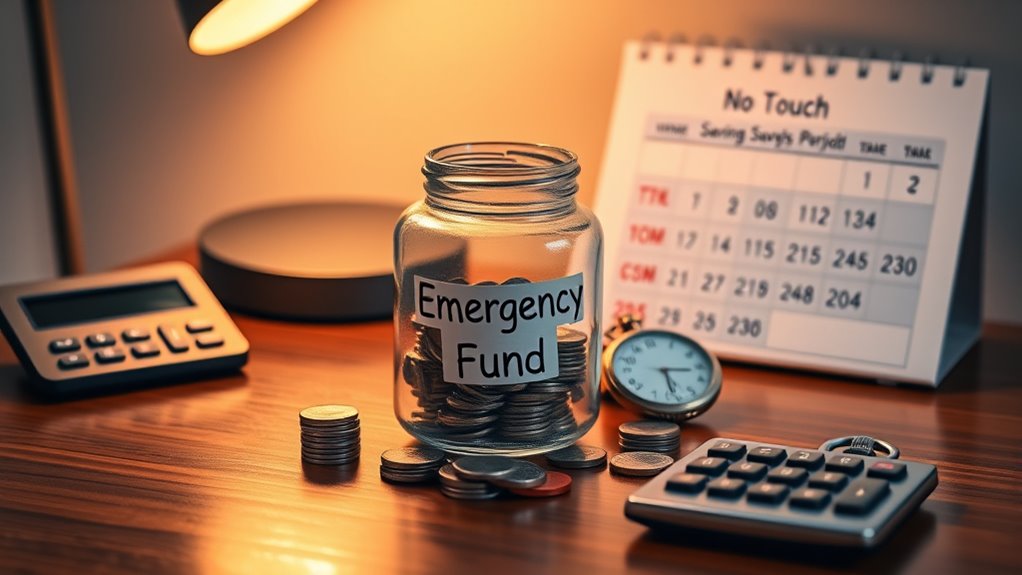To save money quickly, set up automatic round-ups with apps like Acorns or Chime®, which transfer spare change into your savings. Try the 100 Envelope Challenge by dividing goals into small, manageable amounts. Pause or cancel unnecessary subscriptions and plan meals with coupons to cut food costs. Use coin-counting machines for loose change, join weekly savings challenges, and look for free community resources. If you keep exploring, you’ll discover even more clever ways to boost your savings quickly.
Key Takeaways
- Automate savings with apps’ round-up features and scheduled transfers to build funds effortlessly.
- Use physical or digital envelopes for small, incremental savings, making goals tangible and engaging.
- Remove temptation by eliminating triggers like shopping apps and social media notifications.
- Opt for high-yield savings accounts or CDs to maximize interest with minimal effort.
- Participate in community challenges or swap meets to save money and boost savings motivation.
Automate Your Savings With Round-Ups and Apps

Automating your savings has become easier and more effective thanks to innovative apps and features like round-ups. When you make purchases, these apps round up the amount to the nearest dollar and transfer the spare change directly into your savings or investment accounts. For example, Chime® offers a “keep the change” feature with a competitive 1.25% APY, making saving effortless. Acorns automatically invests your rounded-up spare change, helping you grow your money with small, consistent contributions. Most of these apps let you link your debit or credit cards, ensuring passive savings happen automatically with every transaction. This approach takes the guesswork out of saving, making it seamless to build your savings without actively thinking about it. Understanding time zones can also help you optimize your financial planning and transfer timings across different regions. Utilizing automatic transfers can further streamline your savings process by scheduling regular contributions that align with your income cycle. Additionally, setting alerts can remind you to review your savings goals and adjust your round-up preferences as needed.
Embrace the 100 Envelope Challenge for Steady Growth

To make the 100 Envelope Challenge work for you, set clear incremental savings goals and stick to them. Randomizing which envelopes you pick keeps the process engaging and prevents saving fatigue. Keep track of your progress consistently to stay motivated and see how your steady growth adds up over time. Tracking your savings helps you recognize patterns and adjust your approach as needed to maximize your success. Additionally, understanding how juice detox side effects and online privacy settings can influence your browsing experience can help you better manage your online financial tools and resources.
Set Incremental Savings Goals
Setting incremental savings goals can make building your emergency fund more manageable and less overwhelming. By focusing on small, daily targets, you build momentum and confidence. The 100 Envelope Challenge exemplifies this approach, where each envelope represents a specific amount, from $1 to $100. This method encourages steady growth and keeps your motivation high. To maximize this, consider these key points: – Break down larger savings into smaller, achievable steps to avoid feeling discouraged – Use visual cues, like envelopes or digital trackers, to reinforce your progress – Adjust the timeline or amounts if your budget changes, maintaining flexibility Utilize user-friendly apps or journals to efficiently track your progress]. Research shows that visual tracking and incremental goals significantly improve savings consistency.
Randomize Envelope Amounts
Embracing random envelope amounts in the 100 Envelope Challenge adds an element of surprise that keeps your saving routine engaging. Instead of following a fixed order, you select envelopes randomly—either by shuffling physically or using a digital generator. This unpredictability makes each saving day feel different, blending small and large amounts to prevent monotony. It also reduces the mental stress of planning for large deposits every day, helping you stay motivated. The total savings, $5,050, accumulates over time, turning saving into a fun, gamified experience. The randomness encourages you to save larger sums gradually, building discipline without feeling overwhelmed. Plus, the element of surprise can boost your motivation, making it easier to stick with the challenge and develop long-term saving habits. Incorporating iterative processes into your savings approach can help you refine your strategy and stay on track with your financial goals. Additionally, engaging in practices that promote mind-body awareness, such as mindfulness, can enhance your overall focus and commitment to your savings journey. Understanding the psychology of savings can also help you stay motivated and overcome common obstacles.
Track Progress Consistently
Consistently tracking your progress is essential for making steady gains in the 100 Envelope Challenge. It keeps you accountable and provides clear visuals of your achievements. By daily picking an envelope, you set a specific savings target each day, reinforcing discipline. Recording each amount boosts motivation and helps identify patterns or setbacks. Using a physical container or digital tracker centralizes your efforts, making it easier to stay organized. In addition, many people find that visualizing their savings journey enhances their commitment and makes the process more engaging. Incorporating cookie preferences ensures your tracking tools function smoothly and respects your privacy. Additionally, understanding Kia Tuning can inspire you to stay committed to your own personal growth and change. Keeping your goals in mind can further motivate you to stay consistent and disciplined. – Visual progress fuels motivation and keeps you focused. – Accountability encourages commitment and reduces impulsive spending. – Regular reviews help you adjust timing or amounts for better results.
Staying consistent turns savings into a habit, making it easier to reach your goal of $5,050. Tracking doesn’t just monitor progress—it sustains your momentum.
Commit to a No-Touch Savings Period

To build your savings effectively, set a clear timeframe for leaving your funds untouched, whether a few months or longer. Lock your money in secure accounts like CDs or high-yield savings to prevent easy access and reduce temptation. By avoiding triggers that prompt impulsive spending, you’ll strengthen your discipline and see your savings grow faster. FDIC insurance can provide added peace of mind, knowing your funds are protected up to $250,000 per depositor. Additionally, choosing accounts with interest accrual can help your savings grow more quickly over time. Recognizing financial discipline as a key factor can further enhance your ability to save consistently and reach your savings goals more efficiently. Understanding the importance of a high contrast ratio in projectors can also inspire you to seek quality investments that maximize your savings potential.
Set a Clear Timeframe
Have you ever wondered how setting a specific timeframe can boost your savings efforts? When you define a clear deadline, it gives you a concrete goal to aim for and boosts your motivation. This time limit helps prevent impulsive withdrawals, reinforcing discipline and creating a habit of consistent saving. It also makes tracking progress easier, so you can review and adjust your approach as needed. Savings accounts are designed to help you reach these goals by offering a secure place to grow your money over a set period. Choosing the right savings vehicle depends on your timeframe:
- Certificates of Deposit lock funds until maturity, ideal for long-term goals.
- High-yield savings accounts offer flexibility while earning interest rates that can accelerate your savings.
- Savings bonds and club accounts provide fixed periods with penalties for early withdrawal.
Additionally, understanding building codes and zoning regulations can help you plan for future expansions or modifications if your savings goal involves property improvements or tiny house projects. A defined timeframe keeps your focus sharp, making your savings journey more effective and goal-oriented.
Lock Funds Securely
Locking in your savings with specific accounts can help prevent impulsive spending and keep your goals on track. Certificates of Deposit (CDs) require depositing a fixed sum for a set period, during which early withdrawals usually incur penalties. These accounts offer higher, fixed interest rates that can boost your savings and protect against market fluctuations. While savings accounts don’t technically lock funds, they limit withdrawals—often to six per month—encouraging disciplined saving. Locking funds through these options creates mental commitment and reduces temptation, helping your money grow faster. FDIC insurance ensures your principal remains safe, and regulations enforce withdrawal limits. Choosing the right locked savings vehicle depends on your goals and timing, but committing to a no-touch period markedly enhances your savings discipline and growth potential. Interest rates on CDs are often higher than those on regular savings accounts, which can significantly increase your earnings over time.
Avoid Temptation Triggers
Eliminating temptation triggers is essential for maintaining your savings discipline. When environmental cues like credit cards or shopping apps are within reach, impulse spending becomes easier. Notifications from retailers, sales alerts, or promotional emails often lure you into unplanned purchases. Frequent visits to malls, online marketplaces, or browsing social media expose you constantly to spending temptations. Having cash or accessible credit in your wallet or online makes spontaneous spending tempting. Peer pressure or social activities centered around spending can also undermine your savings goals. To combat this, consider these strategies:
- Remove physical triggers like credit cards or shopping apps.
- Turn off notifications from retailers and social media.
- Limit visits to shopping environments and avoid trigger environments during your no-touch period.
- Recognize that self-control plays a crucial role; developing habits to resist urges can significantly improve your savings success.
Turn Loose Change Into Cash With Coin-Counting Machines

Turning loose change into cash becomes quick and easy when you use coin-counting machines. These machines process coins by feeding them into a hopper, where mechanical sorting stations separate coins by size and diameter. Electronic sensors then identify each coin’s value based on size, weight, and electromagnetic properties. Sorted coins fall into designated bins, and the total amount appears on a digital display—some machines even print receipts for record-keeping. Using coin counters saves time, reduces errors, and streamlines the process of counting large quantities of change. Many machines can detect counterfeit coins, enhancing security. Modern coin counters utilize electronic sensors for precise identification, and to maximize efficiency, feed coins in consistent batches, keep the machine clean, and consider locations like banks or supermarkets that offer free counting services. Turning loose change into cash has never been simpler.
Take on Weekly Savings Challenges for Discipline

Taking on weekly savings challenges can help build consistent discipline and make saving money an achievable habit. These challenges push you to set clear goals and stay committed, whether you’re saving a small percentage of your income or increasing deposits gradually. For example, a percentage-based challenge adjusts automatically with income changes, fostering sustainability. The traditional 52-week challenge encourages steady growth by increasing fixed amounts weekly, while short-term challenges focus on quick gains for urgent goals. Multi-level challenges push higher-income savers to accelerate savings, and envelope or automated methods add control and simplicity. By adopting one of these challenges, you develop habits that turn saving into a routine, making it easier to reach your financial goals faster and with less stress.
- Build steady discipline through incremental progress
- Adapt challenges to your income and goals
- Make saving a consistent, achievable habit
Rethink Your Daily Routes to Cut Impulse Spending

By rethinking your daily routes, you can avoid areas with frequent shopping or fast-food outlets that trigger impulse buys. Planning alternative paths helps you stay focused on your goals and reduces temptation. Small route adjustments can make a big difference in controlling unnecessary spending. Additionally, optimizing your routes with smarter planning tools can further enhance your ability to stay on track and minimize unplanned expenses through route optimization.
Identify Hidden Temptations
Have you ever considered how your daily routes and environments influence your impulse spending? Recognizing hidden temptations can help you cut unnecessary expenses. For instance, market days are especially tempting, with 69% of people feeling more prone to spend. Carrying cash in trading centers increases the lure by 66%, making it easier to overspend. Small, impulsive purchases—like those driven by social media trends—also add up quickly. To identify these hidden costs, pay attention to:
- Regular subscriptions or insurance plans that quietly drain your budget
- Overlooked expenses like taxes or fees that go unnoticed
- The tendency to avoid reviewing statements, allowing sneaky charges to accumulate
- Being aware of the times and places where you are most likely to make impulsive purchases can help you develop better strategies to avoid unnecessary spending as research shows that certain environments and routines trigger impulsive buying.
Plan Alternative Routes
Reevaluating your daily routes can considerably reduce impulsive spending and hidden expenses. By planning smarter paths, you cut fuel costs, vehicle wear, and accident risks. Advanced route software can lower transportation costs by 10-30%, saving money while boosting efficiency. Shorter routes mean less idling and lower emissions, aligning with eco-friendly goals. Plus, optimized routing allows you to handle more tasks daily without expanding your fleet.
| Benefit | Impact | Additional Savings |
|---|---|---|
| Reduced Fuel Use | Cuts fuel expenses | Less environmental footprint |
| Less Vehicle Wear | Decreases maintenance costs | Extends vehicle lifespan |
| Fewer Accidents | Saves accident-related costs | Improves safety and reputation |
| Increased Capacity | More deliveries per day | Higher revenue potential |
Slash Expenses by Pausing or Dropping Subscriptions

Pausing or dropping subscriptions offers a straightforward way to cut down on unnecessary expenses without sacrificing access to the services you value. By doing so, you can immediately reduce your monthly costs and prevent wasteful spending on services you no longer use. This flexibility is especially helpful when budgets tighten or priorities shift. Consider these strategies:
- Regularly review your subscriptions to identify unused or unnecessary ones.
- Use pause options to maintain access while avoiding full cancellation, keeping loyalty intact.
- Focus on services that no longer bring value or have become redundant with free alternatives.
These steps help you stay in control of your expenses, reduce clutter, and boost savings—all without losing access to the essentials. Flexibility allows you to adapt your spending to your current financial situation.
Plan Meals Ahead and Use Coupons to Reduce Food Costs

Planning your meals in advance can considerably cut food costs while improving your nutrition. It helps you avoid impulsive buys, saving up to 25% on groceries. By organizing your meals, you can buy in bulk and use ingredients efficiently, reducing food waste, which accounts for about 30-40% of food loss at home. Using meal plans based on USDA Low-Cost Food Plans ensures your diet stays nutritious and affordable. Additionally, preparing meals ahead of time allows you to incorporate leftovers and stick to your budget, avoiding expensive convenience foods. To maximize savings, combine coupons with store sales and loyalty programs. Organize your coupons by expiration date and product category, and keep an eye on local flyers to match deals with your meal plans.
Use Free Resources and Community Exchanges to Save

Taking advantage of free resources and community exchanges can considerably cut your expenses while fostering local connections. Your local library offers free books, digital media, internet access, workshops, and even specialty tools like 3D printers and sewing machines. Community swap meets and exchanges help you save on clothing, tools, books, toys, and even homegrown produce, promoting sustainable living. Online platforms like Facebook Groups and Nextdoor make it easy to barter skills, share items, or find freebies within your neighborhood. These resources not only reduce costs but build stronger local bonds.
- Access to free workshops, media, and tools at libraries
- Swapping clothes, books, and food with neighbors
- Online bartering and sharing via community platforms
Maximize Benefits From Your Employer and Financial Institutions

Maximizing benefits from your employer and financial institutions can substantially boost your savings and financial security. Take advantage of Flexible Spending Accounts (FSAs), which let you use pre-tax dollars for medical or dependent care expenses—saving about 30% on taxes. Your employer also benefits by saving on FICA taxes, which can lead to more generous contributions or lower costs. For retirement, enroll in your company’s 401(k) plan and opt for automatic increases; a match from your employer is an immediate return on your money. Consider Health Savings Accounts (HSAs) paired with high deductible health plans to grow tax-free savings for medical costs. Additionally, explore employer-sponsored emergency savings accounts or loan repayment programs to build a financial cushion, reducing reliance on costly debt. Employee participation in FSAs can increase employer savings significantly, creating more resources for employee benefits. These strategies maximize your savings potential and financial stability.
Frequently Asked Questions
How Can I Start Saving More Without Feeling Deprived?
You want to save more without feeling deprived, so start by setting clear, achievable goals to keep you motivated. Track your spending to identify unnecessary expenses and make small cuts where possible. Allocate a specific portion of your income for savings and allow yourself some guilt-free spending for enjoyment. Automate your savings to stay consistent, and remember to celebrate milestones to stay motivated and balanced.
What Are the Best Apps for Automating Savings?
When choosing the best apps for automating savings, you want options that fit your lifestyle. Oportun automatically transfers safe amounts, perfect if you prefer hands-free saving. Acorns rounds up your purchases and invests your spare change, ideal for gradual growth. Plum uses AI to analyze your finances and save smartly, while Qapital lets you set and forget multiple goals. These apps make saving effortless, so you can focus on your financial progress.
How Do I Stay Motivated With Savings Challenges Long-Term?
To stay motivated with savings challenges long-term, focus on personal goals that truly matter to you, like a dream vacation or a new home. Automate your savings to make it effortless, and track your progress regularly to see how far you’ve come. Break big goals into smaller milestones for quick wins, and consider having an accountability partner for encouragement. Keep reminding yourself of your “why” to stay committed and inspired.
Can I Combine Multiple Savings Hacks Effectively?
You can definitely combine multiple savings hacks effectively. Start by using separate accounts for different goals to stay organized and motivated. Automate transfers to boost discipline and track progress easily. Mix high-yield accounts for better interest and local banks for convenience. Regularly review and adjust your setup to balance security, earnings, and simplicity, ensuring you maximize benefits without overcomplicating your savings strategy.
What Unexpected Expenses Should I Plan for When Saving?
Planning for pesky, pricey, and unpredictable expenses is key. You should set aside funds for sudden car repairs, surprise home fixes, and unexpected medical emergencies. Even smaller setbacks like minor mishaps or miscellaneous costs can strain your savings. By preparing for these pressing, unpredictable problems, you guarantee you’re not caught off guard. Building a buffer helps you better beat financial burdens, leaving you more confident and calmer when crises come knocking.
Conclusion
By blending bold budgeting, clever challenges, and consistent commitments, you can create a carefree cash cushion. Embrace easy, effective strategies like automating, adjusting, and accessing affordable resources. With a little discipline and determination, you’ll develop a dynamic, debt-free destiny. Remember, small savings spark significant success, turning your financial fears into future freedoms. Start smart today—savor the satisfaction of a secure, savings-savvy tomorrow.









